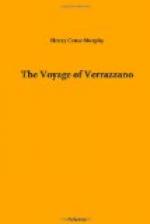reign of Francis, and it, no doubt,
represents not only the state of geographical knowledge
in France at that time, but also all the knowledge
possessed by Francis of this coast. Mr. Kohl
expresses the opinion that it “is not only one
of the most brilliant, but also one of the most exact
and trustworthy pictures of the world which we have
in the first part of the sixteenth century. It
gives accurately all that was known of the world in
1543, especially of the ocean, and the outlines of
the coasts of different countries.” He
adds, “the author of the map must have been
a well instructed, intelligent and conscientious man.
Where the coasts of a country are not known to him,
he so designates them. For his representations
of countries recently discovered and already known,
he had before him the best models and originals.”
[Footnote: Discovery of Maine, 351-4.] Yet notwithstanding
the thorough knowledge of the subject displayed by
this cartographer, his French nationality, and the
contemporariness of his labors with the reign of Francis,
“no evidence,” as Mr. K. further observes,”
appears that the report or chart of the French commander,
Verrazzano, had been used in constructing this chart.”
On the contrary, the line of coast from Cape St. Roman
in South Carolina to Cape Breton is copied from the
Spanish map of Ribero, with the Spanish names translated
into French. [Footnote: Thus R. del principe,
R. del espiritu santo, B. de Santa Maria (the Chesapeake)
Playa, C. de S. Juan, R. de St. Iago, C. de Arenas
(Cape Henlopen), B. de S. Christoval (the Delaware),
B. de S. Antonio (the Hudson), R. de buena Madre,
S. Juan Baptista, Arcipelago de Estevan Gomez, Montanas,
and R. de la buelta, on the map of Ribero, become on
the French map, R. du Prince, R. du St. Esprit, B.
de Sa. Marie, Les playnes, C. St. Jean, St. Jacques,
C. des Sablons, G. de St. Christofle, R. de St. Anthoine,
R. de bonne Mere, Baye de St. Jean Baptiste, Arcipel
de Estienne Gomez, Les Montaignes and R. de Volte.]
Many other names occur within the same distance, which
are found on other Spanish charts since that time,
and some which were probably taken from Spanish charts
not now known. [Footnote: Of this class are the
R. de Canoes, R. Seche, Playne, Coste de Dieu, R.
d’Arbres, which, on the map XII, of the Munich
Atlas, said to have been taken from the map of the
Spanish cosmographer, Alonzo de Santa Cruz, are given,
R. de Canoas, R. Seco, Terra Ilana, Costa de Diego,
R. d’Arvoredos.] Thus within the limits mentioned,
embracing the exploration of Gomez no designation
occurs connecting the coast with Verrazzano. [Footnote:
The name of Avorobagra, on the west side of the great
bay, is found in place of C. de Muchas illas of the
Ribero map. This is supposed to have been intended
for Norumbega.] From Cape Breton easterly and northerly
along the coast of Newfoundland the discoveries of
the Normand and Bretons and the Portuguese, and in
the river and gulf of St. Lawrence, those of Jacques




